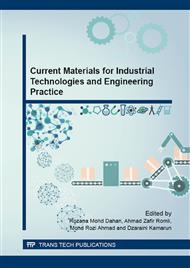p.56
p.61
p.66
p.70
p.75
p.82
p.88
p.96
p.103
Rubber-Solvent Interaction Parameter (χ1,2) of NR/SBR Rubber Blend Solution in Determination of Crosslink Concentration for Vulcanized Rubber Blend
Abstract:
Crosslink concentration is an important property affecting the major characteristic of cured rubber. One of the important parameter to determine the crosslink concentration of a vulcanized rubber by swelling measurement is the rubber-solvent interaction parameter known as ‘kai’ value denoted as χ. For single rubber, the χ value is known however, the χ1,2 for rubber blends are unknown. This research concerned with the investigation to determine the χ1,2 for rubber blends solution (uncured rubber). Natural rubber (NR) and styrene butadiene rubber (SBR) rubber blends solution were blend at 7 different ratios of 100/0, 80/20, 70/30, 60/40, 50/50, 40/60 and 0/100 and were dissolved in toluene. The χ1,2 value of each rubber blends were determined based on the intrinsic viscosity measurement. Crosslink concentrations of vulcanized rubber blends obtained from the swelling measurement were then compared against the value determined from simple extension measurement (stress-relaxation method). This cross-checking was to ensure the accuracy and reliability of χ1,2 value for rubber blends solution.
Info:
Periodical:
Pages:
75-81
Citation:
Online since:
December 2015
Price:
Сopyright:
© 2016 Trans Tech Publications Ltd. All Rights Reserved
Share:
Citation:


